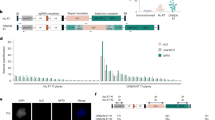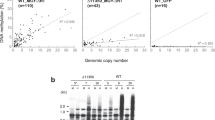Abstract
Excision by transposons is associated with chromosome breaks; generally, host-cell proteins repair this damage, often introducing mutations. Many transposons also use host proteins in the transposition mechanism or in regulation1,2,3,4. Transposition in systems lacking host factors that influence the behaviour of these transpositions is useful in determining what those factors are and how they work. In addition, features of transposition and regulation intrinsic to the element itself can be determined. Maize Activator/Dissociation (Ac/Ds) elements transpose in a wide variety of heterologous plants, but their characteristics in these other systems differ from those in maize, including their response to increasing genetic dosage5,6 and the types of repair products recovered following excision7. Two Arabidopsis thaliana mutants (iae1 and iae2) show increased Ac transposition frequencies8. These mutants, and the differences mentioned above, suggest the involvement of host proteins in Ac/Ds activity and potential differences between these proteins among plant species. Here we report that Ac/Ds elements, members of the hAT (hobo, Ac, Tam3) superfamily, transpose in the yeast Saccharomyces cerevisiae, an organism lacking class II (‘cut and paste’) transposons. This demonstrates that plant-specific proteins are not essential for Ac/Ds transposition. The yeast system is valuable for dissecting the Ac/Ds transposition mechanism and identifying host factors that can influence transposition and the repair of DNA damage induced by Ac/Ds. Mutations caused by Ds excision in yeast suggest formation of a DNA-hairpin intermediate, and reinsertions occur throughout the genome with a frequency similar to that in plants. The high proportion of Ac/Ds reinsertions also makes this system an in vivo mutagenesis and reverse genetics tool in yeast and, presumably, other eukaryotic systems.
This is a preview of subscription content, access via your institution
Access options
Subscribe to this journal
Receive 12 print issues and online access
$209.00 per year
only $17.42 per issue
Buy this article
- Purchase on Springer Link
- Instant access to full article PDF
Prices may be subject to local taxes which are calculated during checkout




Similar content being viewed by others
References
Beall, E.L. & Rio, D.C. Drosophila IRBP/Ku p70 corresponds to the mutagen-sensitive mus309 gene and is involved in P-element excision in vivo. Genes Dev. 10, 921–933 (1996).
Signon, L. & Kleckner, N. Negative and positive regulation of Tn10/IS10-promoted recombination by IHF: two distinguishable processes inhibit transposition off of multicopy plasmid replicons and activate chromosomal events that favor evolution of new transposons. Genes Dev. 9, 1123–1136 (1995).
Surette, M.G., Lavoie, B.D. & Chaconas, G. Action at a distance in Mu DNA transposition: an enhancer-like element is the site of action of supercoiling relief activity by integration host factor (IHF). EMBO J. 8, 3483–3489 (1989).
Makris, J.C., Nordmann, P.L. & Reznikoff, W.S. Integration host factor plays a role in IS50 and Tn5 transposition. J. Bacteriol. 172, 1368–1373 (1990).
Keller, J. et al. Effects of gene dosage and sequence modification on the frequency and timing of transposition of the maize element Activator (Ac) in tobacco. Plant Mol. Biol. 21, 157–170 (1993).
Swinburne, J., Balcells, L., Scofield, S.J., Jones, J.D.G. & Coupland, G. Elevated levels of Activator transposase mRNA are associated with high frequencies of Dissociation excision in Arabidopsis. Plant Cell 4, 583–595 (1992).
Rinehart, T.A., Dean, C. & Weil, C.F. Comparative analysis of non-random DNA repair following Ac transposon excision in maize and Arabidopsis. Plant J. 12, 1419–1427 (1997).
Jarvis, P., Belzile, F., Page, T. & Dean, C. Increased Ac excision (iae): Arabidopsis thaliana mutations affecting Ac transposition. Plant J. 11, 907–919 (1997).
Kunze, R., Kühn, S., Jones, J.D.G. & Scofield, S.R. Somatic and germinal activities of maize Activator (Ac) transposase mutants in transgenic tobacco. Plant J. 8, 45–54 (1995).
Houba-Hérin, N., Becker, D., Post, A., Larondelle, Y. & Starlinger, P. Excision of a Ds-like maize transposable element (Ac Δ) in a transient assay in Petunia is enhanced by a truncated coding region of the transposable element Ac. Mol. Gen. Genet. 224, 17–23 (1990).
Feldmar, S. & Kunze, R. The ORFa protein, the putative transposase of maize transposable element Ac, has a basic DNA binding domain. EMBO J. 10, 4003–4010 (1991).
Kunze, R. et al. Dominant transposition-deficient mutants of maize Activator (Ac) transposase. Proc. Natl Acad. Sci. USA 90, 7094–7098 (1993).
Essers, L., Adolphs, R. & Kunze, R. A highly conserved domain of the maize Activator transposase is involved in dimerization. Plant Cell 12, 211–224 (2000).
Kunze, R., Saedler, H. & Lönnig, W.-E. Plant transposable elements. Adv. Bot. Res. 27, 331–470 (1997).
McClintock, B. Chromosome organization and genic expression. Cold Spring Harb. Symp. Quant. Biol. 16, 13–47 (1951).
Scofield, S.R., English, J.J. & Jones, J.D.G. High level expression of the Activator (Ac) transposase gene inhibits the excision of Dissociation (Ds) in tobacco cotyledons. Cell 75, 507–517 (1993).
Heinlein, M., Brattig, T. & Kunze, R. In vivo aggregation of maize Activator (Ac) transposase in nuclei of maize endosperm and Petunia protoplasts. Plant J. 5, 705–714 (1994).
Atkinson, P.W., Warren, W.D. & O'Brochta, D.A. The hobo transposable element of Drosophila can be cross-mobilized in houseflies and excises like the Ac element of maize. Proc. Natl Acad. Sci. USA 90, 9693–9697 (1993).
Coen, E.S., Robbins, T.P., Almeida, J., Hudson, A. & Carpenter, R. Consequences and mechanism of transposition in Antirrhinum majus. in Mobile DNA (eds Berg, D.E. & Howe, M.M.) 413–436 (American Society for Microbiology, Washington DC, 1989).
Colot, V., Haedens, V. & Rossignol, J.-L. Extensive, nonrandom diversity of excision footprints generated by Ds-like transposon Ascot-1 suggests new parallels with V(D)J recombination. Mol. Cell. Biol. 18, 4337–4346 (1998).
Hiom, K., Melek, M. & Gellert, M. DNA transposition by the Rag1 and Rag2 proteins: a possible source of oncogenic translocations. Cell 94, 463–470 (1998).
Agrawal, A., Eastman, Q.M. & Schatz, D.G. Transposition mediated by RAG1 and RAG2 and its implications for the evolution of the immune system. Nature 394, 744–751 (1998).
Daboussi, M.J. & Langin, T. Transposable elements in the fungal plant pathogen Fusarium oxysporum. Genetica 93, 1–3 (1994).
Kempken, F. & Kück, U. restless, an active Ac-like transposon from the fungus Tolypocladium inflatum: structure, expression, and alternative RNA splicing. Mol. Cell. Biol. 16, 6563–6572 (1996).
Laufs, J. et al. Wheat dwarf virus Ac/Ds vectors: expression and excision of transposable elements introduced into various cereals by a viral replicon. Proc. Natl Acad. Sci. USA 87, 7752–7756 (1990).
Gietz, R.D. & Sugino, A. New yeast- Escherichia coli shuttle vectors constructed with in vitro mutagenized yeast genes lacking six-base pair restriction sites. Gene 74, 527–534 (1988).
Wach, A. PCR-synthesis of marker cassettes with long flanking homology regions for gene disruptions in S. cerevisiae. Yeast 12, 259–265 (1996).
Mumberg, D., Müller, R. & Funk, M. Regulatable promoters of Saccharomyces cerevisiae: comparison of transcriptional activity and their use for heterologous expression. Nucleic Acids Res. 22, 5767–5768 (1994).
Acknowledgements
We thank M. Hilpert and L. Petrov for technical assistance, and C. Koch and C. Lechelt-Kunze for comments and suggestions. This work was supported by a Heisenberg-fellowship from Deutsche Forschungsgemeinschaft (to R.K.) and by US Dept. of Agriculture award 9801432 and the Binational Agriculture Research and Development Fund (to C.F.W).
Author information
Authors and Affiliations
Corresponding author
Rights and permissions
About this article
Cite this article
Weil, C., Kunze, R. Transposition of maize Ac/Ds transposable elements in the yeast Saccharomyces cerevisiae. Nat Genet 26, 187–190 (2000). https://doi.org/10.1038/82827
Received:
Accepted:
Issue Date:
DOI: https://doi.org/10.1038/82827
This article is cited by
-
Mobility of mPing and its associated elements is regulated by both internal and terminal sequences
Mobile DNA (2023)
-
Transgenic direct terminal repeats of Dissociation (Ds) produce chromosomal breakage in maize
The Nucleus (2023)
-
Functional characterization of the active Mutator-like transposable element, Muta1 from the mosquito Aedes aegypti
Mobile DNA (2017)
-
CYCLOIDEA 2 Clade Genes: Key Players in the Control of Floral Symmetry, Inflorescence Architecture, and Reproductive Organ Development
Plant Molecular Biology Reporter (2017)
-
Transposable elements in the Anopheles funestus transcriptome
Genetica (2017)



